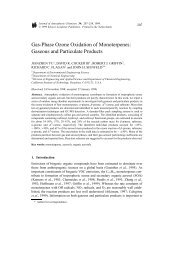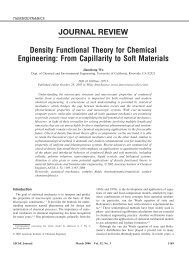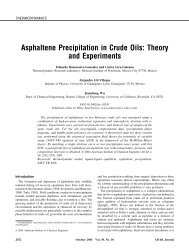DEVELOPMENT OF REVISED SAPRC AROMATICS MECHANISMS
DEVELOPMENT OF REVISED SAPRC AROMATICS MECHANISMS
DEVELOPMENT OF REVISED SAPRC AROMATICS MECHANISMS
You also want an ePaper? Increase the reach of your titles
YUMPU automatically turns print PDFs into web optimized ePapers that Google loves.
INTRODUCTION<br />
Airshed models are essential for the development of effective control strategies for reducing<br />
photochemical air pollution because they provide the only available scientific basis for making<br />
quantitative estimates of changes in air quality resulting from changes in emissions. The chemical<br />
mechanism is the portion of the model that represents the processes by which emitted primary pollutants,<br />
such as volatile organic compounds (VOCs) and oxides of nitrogen (NO x ), interact in the gas phase to<br />
form secondary pollutants such as ozone (O 3 ) and other oxidants. This is an important component of<br />
airshed models because if the mechanism is incorrect or incomplete in significant respects, then the<br />
model's predictions of secondary pollutant formation may also be incorrect, and its use might result in<br />
implementation of inappropriate or even counter-productive air pollution control strategies.<br />
One airshed model application where the accuracy of the chemical mechanism is important is the<br />
calculation of reactivity scales that measure relative impacts of different types of VOCs on ozone<br />
formation. VOCs differ significantly in their impacts on O 3 formation, and regulations that take this into<br />
account are potentially much more cost-effective than those that regulate all VOCs equally. In view of<br />
this, several VOC regulations implemented (or being considered) in California take reactivity into<br />
account. The California regulations use the Maximum Incremental Reactivity (MIR) scale that was<br />
calculated using the <strong>SAPRC</strong>-99 chemical mechanism (Carter, 2000a), but these have been updated to<br />
values calculated using the more recently developed <strong>SAPRC</strong>-07 mechanism (Carter, 2010a,b).<br />
The <strong>SAPRC</strong>-07 mechanism is the latest in the <strong>SAPRC</strong> series of gas-phase chemical mechanisms<br />
(Carter, 1990, 2000a, 2010a,b) that are designed for various airshed model applications. The detailed<br />
version of the mechanism, which has separate reactions for over 700 different types of VOCs and<br />
represents approximately 300 others using the “lumped molecule” approach (Dodge, 2000), is used for<br />
calculating the MIR and other ozone reactivity scales, and serves as the basis for deriving more<br />
condensed mechanisms for airshed model applications where such chemical detail is not required. For<br />
such applications, a lumped mechanism was developed where the many types of emitted VOCs are<br />
represented using a more limited number of lumped model species whose mechanisms are derived based<br />
on those of the mixture of compounds they represent in a standard ambient mixture taken as<br />
representative of anthropogenic VOC emissions (Carter, 2000b, 2010a). Even more condensed versions<br />
of lumped <strong>SAPRC</strong>-07 have been developed using various lumping approximations (Carter, 2009,<br />
2010c,d), but a discussion of this is beyond the scope of this report. But the chemical basis of all these<br />
versions of <strong>SAPRC</strong>-07 is that of the detailed version.<br />
The chemical basis of detailed <strong>SAPRC</strong>-07 is based on results of various laboratory studies,<br />
kinetic and mechanistic data evaluations (e.g., Atkinson, 1989; Atkinson and Arey, 2003; Calvert et al.<br />
2000, 2002; IUPAC, 2006; NASA, 2006), theoretical or “best judgment” estimates, extrapolations, and<br />
interpolations, and results of model simulations of environmental chamber data. Simulations of chamber<br />
data are important because mechanisms for many emitted VOCs are complex and have uncertainties, and<br />
available data, theories, and estimates are not sufficient to fully constrain the mechanism. For this reason,<br />
the predictive capabilities of the mechanisms need to be evaluated by determining if the mechanism can<br />
simulate the results of appropriate environmental chamber experiments, and in some cases uncertain<br />
portions of the mechanism may need to be adjusted for the mechanisms to give satisfactory simulations of<br />
these data. If a mechanism cannot adequately simulate results of well-characterized chamber experiments,<br />
it certainly cannot be relied upon to give accurate predictions in airshed model applications.<br />
The need to evaluate and adjust mechanisms based on simulations of chamber data is particularly<br />
important when deriving mechanisms for aromatic compounds, because of the complexities and<br />
4
















